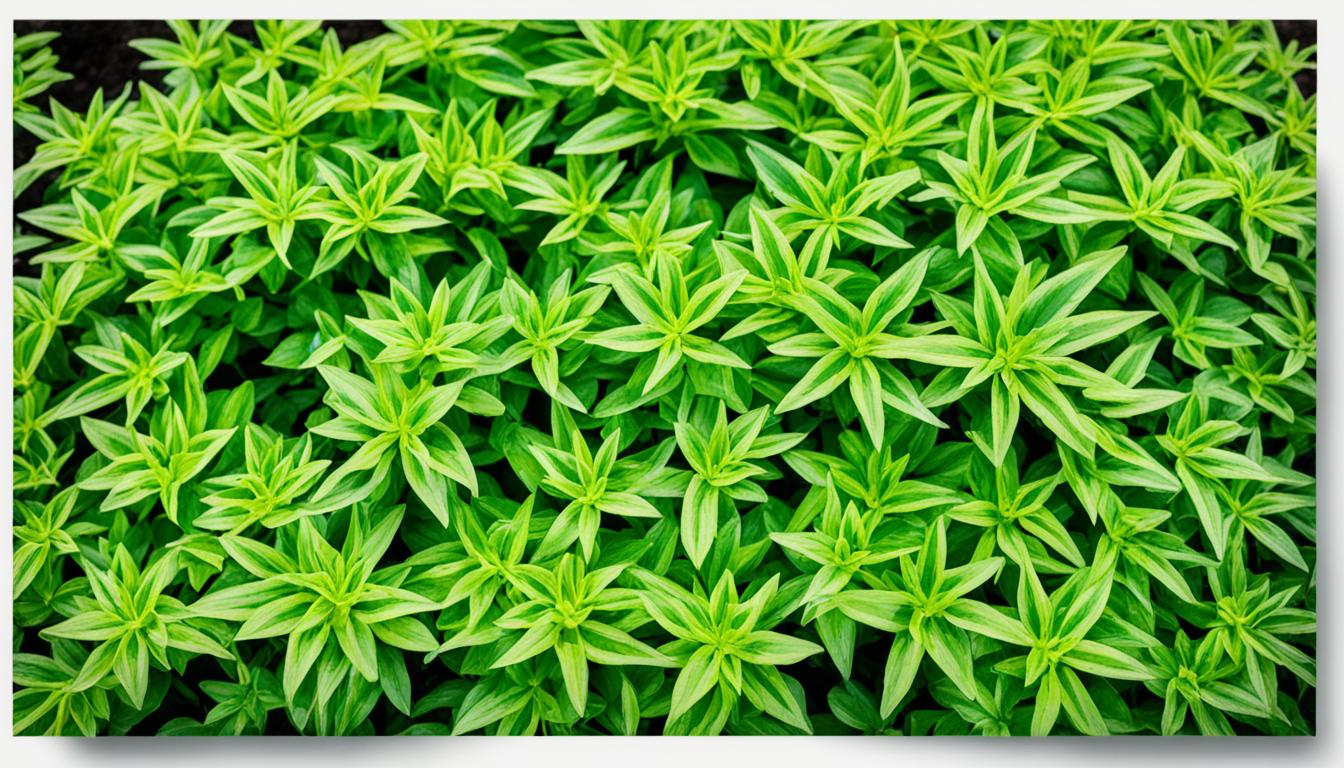Chives and green onions are both key in cooking. They are similar but also have big differences. Knowing these differences can improve your meals a lot.
Chives are herbs that look delicate and are all green. They taste lightly of onions and are best used raw. Green onions, with their milder taste, work well raw or cooked. They have a white base that sometimes curves into a bulb.
Key Takeaways:
- Chives (Allium schoenoprasum) and green onions, or scallions, are both from the Allium family.
- Chives have a delicate, all-green look and a soft onion taste, best enjoyed uncooked.
- Green onions taste milder and can be eaten raw or cooked.
- Understanding their differences will make your cooking better.
- Both add great flavor to many dishes.
What Are Chives and Green Onions?
Chives (Allium schoenoprasum) and green onions, or scallions, are part of the Allium family. This group also includes onions, garlic, leeks, and shallots. While they share traits, chives and green onions have their own unique qualities.
Chives are thin and tender herbs with a soft onion taste. They are completely green. This color makes them a great addition to many meals. People view chives as an herb, used to bring a gentle onion flavor when cooking.
Green onions are seen as a vegetable. They don’t grow into a large bulb. Their white stem slightly turns into the shape of a bulb. This shows they are young vegetables. Green onions taste a bit milder than chives. You can enjoy them both raw or cooked.
Though both are part of the Allium group, chives and green onions stand out. They differ in look and taste. But, both add special flavors and looks to dishes.
Differences Between Chives and Green Onions
Chives and green onions are not the same. They look and taste different. Knowing this can help you pick the right one for your cooking.
“Chives are slimmer and flimsier than green onions, with an entirely green appearance.”
Chives look tender and are fully green. They add a fresh look to food. Green onions are bulkier, with a white base that might have a bulb. This shape shows they are still young. These differences make it easy to tell them apart.
“Chives have a delicate onion flavor that won’t overpower other flavors in a dish.”
Flavor is another key difference. Chives have a light onion taste. They boost a dish’s flavor without taking over. Green onions are milder in comparison. Their onion taste is softer, less intense than chives.
Now you know how chives and green onions differ in looks and taste. This info will help you choose the right one for your recipes.
Comparing the Appearance and Flavor of Chives and Green Onions
| Aspect | Chives | Green Onions |
|---|---|---|
| Appearance | Slim and flimsy, entirely green | Straight white base, may curve into a bulb |
| Flavor | Delicate onion flavor | Slightly milder onion flavor |
How to Use Chives
Chives are a handy herb that can boost the taste and look of many dishes. They work well in dips, spreads, as garnishes, and in omelets. Here’s how you can use chives to make your cooking more exciting:
Culinary Enhancers:
Chives transform dips and spreads with their mild onion taste and fresh vibe. They’re great in a French onion dip or a chive and dill cream cheese. This adds a gentle onion flavor and freshness.
Glorious Garnish:
Deviled eggs become fancier with chives sprinkled on top. This adds color and enhances the creamy filling. It brings elegance to your appetizers.
Flavorful Potatoes:
Potatoes love chives, whether they’re baked or mashed. Just add chopped chives for subtle onion hints and a splash of green. This simple addition makes potatoes even more delightful.
Soups and Stews:
Add chives to soups and stews to finish them off. Sprinkle chopped chives on top for color and a hint of onion. This makes your soups and stews look and taste better.
Salad Sensation:
Chives make salads tastier. Add chopped chives for a light onion flavor. They’re perfect in potato salads, coleslaws, and greens.
Omelet Delight:
Add chopped chives to omelets for freshness. Chives and eggs are a delicious pair. This is an easy way to improve your breakfast or brunch.
Now you know how to use chives in various dishes. Be bold in the kitchen and try them in different recipes. Chives can make your food flavorful and visually appealing.
How to Use Green Onions
Green onions, also known as scallions, bring a mild onion flavor to various meals. They’re perfect for garnishing, boosting the taste of mashed potatoes, omelets, soups, and stews. They also play a big role in Asian cuisine flavors.
For garnishing, green onions are top-notch. Their bright green color and mild taste can make any dish pop. Just slice them thin and sprinkle over salads, roasted veggies, or grilled meats to add both beauty and taste.
Love mashed potatoes? Green onions can make them even better. Chop up some and mix them in for a subtle onion flavor. They add a fresh touch that goes well with creamy potatoes.
Try green onions in your breakfast omelets. Cut them up and mix with eggs before cooking. They add a light onion taste that’s great with cheese, mushrooms, or tomatoes.
In soups and stews, green onions work wonders. They mix well with other ingredients, adding a slight taste depth. Adding finely chopped green onions to chicken soup or beef stew can really lift the flavor.
In Asian dishes, green onions are key. They add flavor and a bit of crispness to stir-fries. Use them in noodle dishes as an ingredient or garnish to boost umami taste. For dumplings, mix finely chopped green onions into the filling for an extra flavor kick.
Green onions enhance dishes as a garnish, in mashed potatoes, omelets, soups, stews, and Asian cuisine. They bring a mild onion taste and a fresh touch.
Green Onions Recipe Ideas
Looking for ways to use green onions? Here are some tasty recipes:
- Cheesy Potato Casserole with Green Onions – A yummy, cheesy dish filled with mashed potatoes, cheese, and green onions. The onions add freshness and go great with the creamy potatoes.
- Green Onion Pancakes – These savory pancakes blend green onions, sesame oil, and soy sauce. They’re an Asian-inspired treat for breakfast or snacks.
- Green Onion and Ginger Shrimp Stir-Fry – A quick, tasty stir-fry with shrimp, green onions, ginger, garlic, and soy sauce. Have it over rice or noodles for a fulfilling meal.
Green onions can do so much in the kitchen. Their mild flavor and versatility enhance many dishes with freshness and depth. Try these recipes or create your own to discover what green onions can do.
Benefits of Chives and Green Onions
Chives and green onions boost your health with their nutrients. Let’s dive into what makes them so good for you.
Chives Nutritional Benefits
Chives are full of important vitamins and minerals. They’re rich in vitamins K, C, and A, thanks to beta carotene. This not only gives them their green color but also fights off cell damage.
Research shows chives can reduce oxidative stress. This lowers disease risk and improves health.
Chives also fight inflammation and have antimicrobial qualities. This can help protect against infections and boost your immune system.
Green Onions Nutritional Benefits
Green onions are nutritious like chives because they’re also allium vegetables. They’re packed with vitamins and minerals.
They contain vitamins K and C, which support the immune system and cell health. These antioxidants are key for a strong body.
Minerals in green onions, like copper, help the body function well. Eating green onions can promote good health, similar to chives.
Visualizing the Benefits
Here’s a detailed comparison table of the vitamins and minerals in chives and green onions:
| Nutrient | Chives (per 100g) | Green Onions (per 100g) |
|---|---|---|
| Vitamin K | 212.7 mcg | 207.5 mcg |
| Vitamin C | 58.1 mg | 7.2 mg |
| Vitamin A | 2,985 IU | 1,002 IU |
| Beta Carotene | 1,695 mcg | 530 mcg |
| Copper | 0.1 mg | 0.1 mg |
The table shows both chives and green onions are great for a healthy diet.
Add chives and green onions to your diet for extra flavor and health benefits. They can make your meals tasty and contribute to your well-being.
Types of Chives
Chives are a diverse group, each type offering its own special taste and look. We have common chives, garlic chives, and Siberian chives. Let’s dive into what makes each one unique.
1. Common Chives (Allium schoenoprasum)
Common chives can be easily found at grocery stores. They’re known for their thin, hollow, dark green leaves. These chives give a gentle onion flavor that brings a nice touch to food without being too strong. They’re great for many kinds of dishes because of their mild taste.
2. Garlic Chives (Allium tuberosum)
Garlic chives stand out because they taste like garlic as well as onion. They have wide, flat leaves and are taller than common chives. Often used in Asian cooking, they add a special and aromatic taste to meals.
3. Siberian Chives (Allium nutans)
Siberian chives look beautiful in gardens thanks to their tall stems and big flowers. They might not be as strong in flavor as the others, but still have that oniony taste. People mostly grow them for how pretty they make their garden look.
All three types of chives bring something special to the table, regardless of their different tastes and looks. Whether you prefer a mild onion taste or a bit of garlic, chives can make your meals tastier.
| Chive Variety | Appearance | Flavor |
|---|---|---|
| Common Chives | Slender, dark green leaves | Mild onion flavor |
| Garlic Chives | Flat, broad leaves | Distinct garlic and mild onion flavor |
| Siberian Chives | Tall, slender stems with larger flowers | Mild onion flavor |
Chives Substitutes
If you need a chives substitute, several options are available. These can give a similar taste to your meals. Whether you’re out of chives or just want to try something new, these alternatives are worth exploring.
Scallions as Chives Substitute
Scallions, or green onions, are a top choice for replacing chives. They have a mild onion flavor that is quite similar. Scallions work in many dishes, offering freshness and a subtle oniony zing.
Onions as Chives Substitute
Onions are another good chives substitute, especially their green parts. They taste stronger but still provide a similar flavor. Both raw and cooked onions can add an oniony touch to your food.
Garlic as Chives Substitute
For dishes needing garlic chives, garlic itself can work well. Green garlic is especially good for matching the mild onion taste of chives. Just use it sparingly to keep the garlic flavor from overwhelming your dish.
Parsley as Chives Substitute
Parsley is a fine chives substitute for adding color and freshness. It lacks the onion taste but looks similar. Use chopped parsley as a garnish to make your dishes pop.
Missing chives shouldn’t stop your cooking adventure. These substitutes can bring a similar taste to your dishes. Try them out to find the best match for your recipes.
How to Cook With Chives
Chives are a great herb that can make your meals taste better. Here’s how to use chives in cooking:
Adding Chives at the End of Cooking
Add chives towards the cooking’s end to keep their flavor strong. This keeps them fresh and tasty.
Chives as a Garnish
Chives are perfect for garnishing. Their bright green color makes any dish look and taste better. Just sprinkle them on potatoes, eggs, soups, and more to boost the flavor and look.
Baking with Chives
You can bake with chives too. Adding them to biscuits or scones gives a savory twist. Their light onion taste is a great match for rich baked foods.
Cooking Tips for Chives
- Slice or snip chives into small pieces to sprinkle on dishes easily.
- Try cooking chives in different ways, like sautéing or grilling, to explore their flavors.
- Mix chives with other herbs like parsley or dill for a tasty blend. Use it in dressings, sauces, or marinades.
To keep chives fresh, store them right. Wrap them in a damp paper towel, put them in a plastic bag, and keep them in the fridge. They’ll last up to two weeks. For even longer storage, freeze chopped chives in a sealed container or freezer bag.
Chives Recipes
Chives are a great ingredient that can make many dishes taste better. They have a mild onion flavor. These recipes will help you enjoy chives in new, tasty ways.
Chive Biscuits Recipe
This chive biscuits recipe adds a special touch to classic biscuits. The blend of buttermilk and chives creates a delicious flavor. You can have these biscuits with a meal or on their own as a snack.
“These chive biscuits are a perfect mix of tangy and savory. The flavor of chives makes the biscuits taste amazing. Enjoy them hot from the oven for a cozy treat.”
Cheesy Chive Waffles Recipe
Upgrade your breakfast with cheesy chive waffles. Chives mixed into the batter give these waffles a special flavor. Serve them with bacon, eggs, or sour cream for a tasty meal.
“Cheesy chive waffles offer a savory take on a morning favorite. Cheese and chives together make them irresistible. Add your preferred toppings for an excellent breakfast.”
Cauliflower Tacos Recipe
Try this cauliflower tacos recipe for a meat-free dish. It includes roasted cauliflower and zesty chive salsa. It’s a great choice for a simple dinner or hanging out with friends and family.
“Cauliflower tacos with chive salsa are a healthy, flavorful option. The roasted cauliflower and chive salsa combine perfectly. These tacos will impress even those who love meat!”
| Recipe | Ingredients | Instructions |
|---|---|---|
| Chive Biscuits | – 2 cups all-purpose flour – 1 tablespoon baking powder – 1/2 teaspoon salt – 1/2 cup unsalted butter, cold and cubed – 1/2 cup buttermilk – 1/4 cup chopped fresh chives |
1. Preheat the oven to 425°F (220°C). 2. In a large mixing bowl, whisk together the flour, baking powder, and salt. 3. Add the cold butter to the flour mixture. Use a pastry cutter or your fingers to cut the butter into the flour until the mixture resembles coarse crumbs. 4. Stir in the buttermilk and chopped chives, mixing until just combined. 5. Turn the dough out onto a lightly floured surface and pat it into a 1-inch (2.5 cm) thick rectangle. 6. Use a biscuit cutter to cut out biscuits from the dough, placing them onto a baking sheet lined with parchment paper. 7. Bake for 12-15 minutes or until the biscuits are golden brown. 8. Serve warm and enjoy! |
| Cheesy Chive Waffles | – 2 cups all-purpose flour – 2 teaspoons baking powder – 1/2 teaspoon baking soda – 1/2 teaspoon salt – 1/4 teaspoon black pepper – 1 cup shredded cheddar cheese – 2 tablespoons chopped fresh chives – 1 3/4 cups buttermilk – 2 large eggs – 1/4 cup unsalted butter, melted |
1. Preheat your waffle iron according to the manufacturer’s instructions. 2. In a large mixing bowl, whisk together the flour, baking powder, baking soda, salt, and black pepper. 3. Stir in the shredded cheddar cheese and chopped fresh chives. 4. In a separate bowl, whisk together the buttermilk, eggs, and melted butter. 5. Pour the wet ingredients into the dry ingredients and stir until just combined. Do not overmix. 6. Lightly grease the waffle iron with cooking spray or melted butter. 7. Ladle the batter onto the preheated waffle iron and cook according to the waffle iron’s instructions, or until golden brown and crispy. 8. Serve the cheesy chive waffles warm with your favorite toppings. |
| Cauliflower Tacos with Chive Salsa | – 1 medium cauliflower, cut into florets – 2 tablespoons olive oil – 1 teaspoon chili powder – 1/2 teaspoon cumin – Salt and pepper, to taste – 8 small tortillas – 1/4 cup chopped fresh chives – 1/2 cup diced tomatoes – 1/4 cup diced red onion – 1 jalapeno, seeded and diced – Juice of 1 lime – Salt, to taste |
1. Preheat the oven to 425°F (220°C). 2. In a large mixing bowl, toss the cauliflower florets with olive oil, chili powder, cumin, salt, and pepper. 3. Spread the seasoned cauliflower on a baking sheet and roast for 20-25 minutes, or until tender and lightly browned. 4. While the cauliflower is roasting, prepare the chive salsa by combining the chopped fresh chives, diced tomatoes, diced red onion, jalapeno, lime juice, and salt in a bowl. Mix well. 5. Warm the tortillas in a dry skillet or microwave according to package instructions. 6. Fill each tortilla with roasted cauliflower and top with chive salsa. 7. Serve the cauliflower tacos with lime wedges and additional toppings, if desired. |
Storage and Shelf Life of Chives
Keeping chives fresh and tasty is important. To do this, put them in a plastic bag in your fridge’s crisper. This stops them from getting soft. Chives stay good for about two weeks this way. Yet, using them quickly is best for their taste.
For a longer shelf life, freezing chives works well. First, cut them into small bits. This makes them easy to use later. Then, store them in something that seals tight, like a container or freezer bag. Push out extra air to avoid freezer burn. Don’t forget to write the freeze date on it.
Ready to use your frozen chives? Just take what you need and thaw them in the fridge or toss them straight into your cooking. Frozen chives keep their taste for months. They’re super handy for recipes that cook for a while, like soups or stews.
Chives, whether cold or frozen, boost your food’s taste when they’re off-season. Keep them right, and you can have their fresh flavor all year.
“Chive storage is crucial for keeping them fresh and tasty. Keep them in the fridge or freeze them for longer use. Having chives ready to go is great for cooking.” – Culinary Expert
| Storage Method | Shelf Life |
|---|---|
| Refrigerator (plastic bag in crisper drawer) | Up to 2 weeks |
| Freezer (chopped and stored in airtight container or freezer bag) | Several months |
Conclusion
Chives and green onions may seem similar, but they are quite different. Chives are herbs with a delicate, green look and taste best raw. They help enhance flavor and add beauty to meals. Meanwhile, green onions, or scallions, give a softer taste and work well both raw and cooked. They feature a white base that sometimes grows into a bulb.
Knowing how chives and green onions differ helps you pick the right one for your cooking. Use chives when you want a light onion taste or a green touch. Choose green onions for a gentler taste, whether in raw slices or cooked dishes. These insights can boost your cooking and make your meals more exciting.
Each has its unique benefits in cooking, from chives’ thin beauty to green onions’ mild versatility. By adding them to your recipes, you can turn your meals into something special. Let these flavorful Alliums lift your cooking to new heights!





